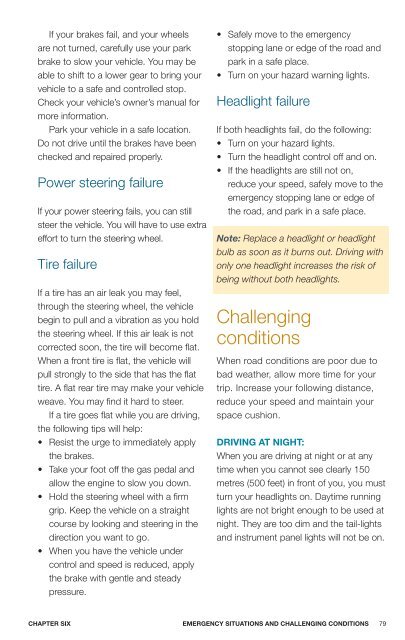DRIVER’S GUIDE
1POl7Ob
1POl7Ob
You also want an ePaper? Increase the reach of your titles
YUMPU automatically turns print PDFs into web optimized ePapers that Google loves.
If your brakes fail, and your wheels<br />
are not turned, carefully use your park<br />
brake to slow your vehicle. You may be<br />
able to shift to a lower gear to bring your<br />
vehicle to a safe and controlled stop.<br />
Check your vehicle’s owner’s manual for<br />
more information.<br />
Park your vehicle in a safe location.<br />
Do not drive until the brakes have been<br />
checked and repaired properly.<br />
Power steering failure<br />
If your power steering fails, you can still<br />
steer the vehicle. You will have to use extra<br />
effort to turn the steering wheel.<br />
Tire failure<br />
If a tire has an air leak you may feel,<br />
through the steering wheel, the vehicle<br />
begin to pull and a vibration as you hold<br />
the steering wheel. If this air leak is not<br />
corrected soon, the tire will become flat.<br />
When a front tire is flat, the vehicle will<br />
pull strongly to the side that has the flat<br />
tire. A flat rear tire may make your vehicle<br />
weave. You may find it hard to steer.<br />
If a tire goes flat while you are driving,<br />
the following tips will help:<br />
• Resist the urge to immediately apply<br />
the brakes.<br />
• Take your foot off the gas pedal and<br />
allow the engine to slow you down.<br />
• Hold the steering wheel with a firm<br />
grip. Keep the vehicle on a straight<br />
course by looking and steering in the<br />
direction you want to go.<br />
• When you have the vehicle under<br />
control and speed is reduced, apply<br />
the brake with gentle and steady<br />
pressure.<br />
• Safely move to the emergency<br />
stopping lane or edge of the road and<br />
park in a safe place.<br />
• Turn on your hazard warning lights.<br />
Headlight failure<br />
If both headlights fail, do the following:<br />
• Turn on your hazard lights.<br />
• Turn the headlight control off and on.<br />
• If the headlights are still not on,<br />
reduce your speed, safely move to the<br />
emergency stopping lane or edge of<br />
the road, and park in a safe place.<br />
Note: Replace a headlight or headlight<br />
bulb as soon as it burns out. Driving with<br />
only one headlight increases the risk of<br />
being without both headlights.<br />
Challenging<br />
conditions<br />
When road conditions are poor due to<br />
bad weather, allow more time for your<br />
trip. Increase your following distance,<br />
reduce your speed and maintain your<br />
space cushion.<br />
DRIVING AT NIGHT:<br />
When you are driving at night or at any<br />
time when you cannot see clearly 150<br />
metres (500 feet) in front of you, you must<br />
turn your headlights on. Daytime running<br />
lights are not bright enough to be used at<br />
night. They are too dim and the tail-lights<br />
and instrument panel lights will not be on.<br />
CHAPTER SIX<br />
EMERGENCY SITUATIONS AND CHALLENGING CONDITIONS 79


